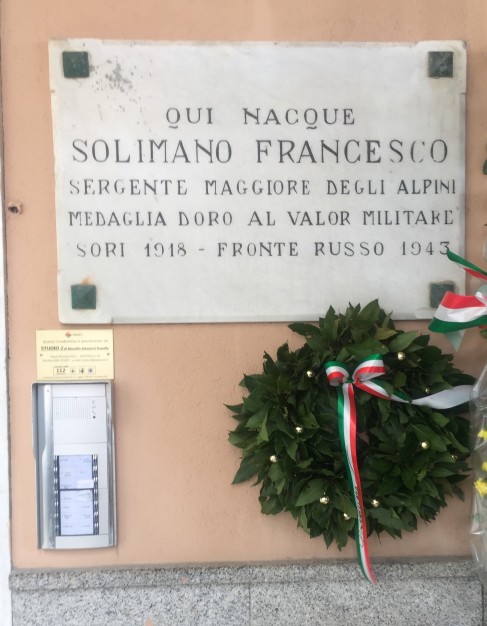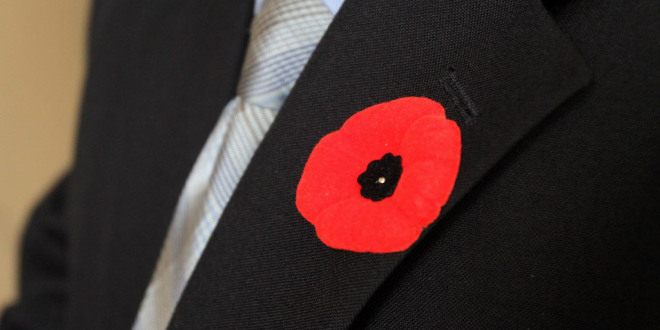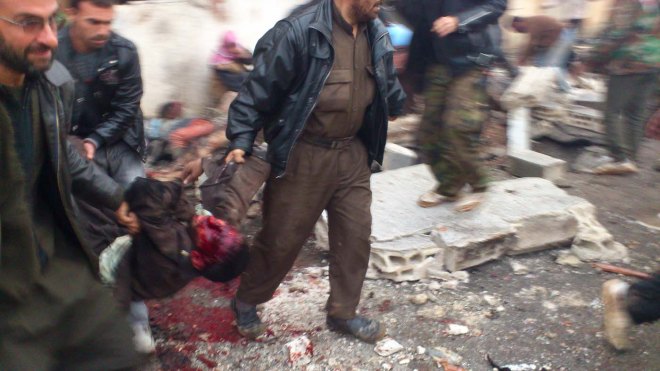Sori, 9 November 2021
My wife and I have finally made it down to the sea. It took a while; we’ve been back in Italy for three weeks. We got here just in time to witness the – very low key – official celebrations on 4th November of the end of the First World War for Italy: the Austro-Hungarian Empire collapsed a week before the German Empire did.
Among other things, a fresh wreath has been fixed to the plaque posed on the wall of the house near the village church where Francesco Solimano was born back in 1918.

The plaque states:
HERE WAS BORN
SOLIMANO FRANCESCO
SERGEANT MAJOR IN THE ALPINE REGIMENTS
GOLD MEDAL FOR MILITARY VALOUR
SORI 1918 – RUSSIAN FRONT 1943
Italy’s “Medaglia d’Oro” is the highest award an Italian soldier can get for bravery on the field of battle. I would say that it’s equivalent to the UK’s Victoria Cross or the US’s Medal of Honor. Readers can imagine, then, that Francesco is the pride of his native village. Along with the plaque on his house, he has received that great accolade of having a village street named after him – the same street, it so happens, which our apartment is located on. A couple of years ago, while we were in the municipal building trying to understand something related to one of the local taxes we were paying, we also stumbled across a photo of Francesco hanging in the corridor.

Readers will note his hat with the feather, the typical hat that all “Alpini” – soldiers in Italy’s Alpine regiments – wear at the various get-togethers which they regularly have. This, for instance, is a get-together in Genova for the Ligurian sections of the Alpini, which Francesco would surely have attended had he lived.

If his photo is anything to go by, Francesco seems to have been a sympathetic fellow. But it wasn’t a smile or a joke that got him his Gold Medal. The official website has his official citation for the medal.
“At the command of a 45-mm mortar squad, during the retreat from the Don he showed exceptional steadfastness by keeping his team steady and efficient, and at its head he participated with legendary valor in repeated hard fighting that took place during ten days of retreat. In the course of the violent offensives, he kept his team at full efficiency by recovering abandoned weapons and ammunition, and so was able to oppose the enemy with renewed ardour and tenacious resistance and react with daring counterattacks. Wounded during a cavalry charge that overwhelmed our lines, he refused aid from the survivors, urged them to fight to the bitter end, and rather than save himself preferred to share the fate of his wounded comrades left on the frozen steppes. An admirable example of absolute dedication to duty and stoic firmness. January 17-26, 1943”
This lyrical description of personal courage skates over the overarching military disaster that the “retreat from the Don” constituted for the Italians. Let me try and describe the titanic battle which took place in late December 1942-early January 1943 between the Soviets and the Axis powers, a battle in which Francesco Solimano and his squad were but a tiny cog.
Francesco Solimano’s squad was part of the 1st Alpine Regiment, which was one of three regiments making up the 4th, or Cuneense, Alpine Division, which, together with the 2nd, Tridentina, Alpine Division and the 3rd, Julia, Alpine Division, made up the Alpine Army Corps. This in turn was one of three Army Corps making up the 8th Italian Army. In early December 1942, the 8th Army was holding a 230-km front along the River Don, north of Stalingrad. Already, attacks by the Soviets in September 1942 had shown that the line was too extended given the Army’s strength and the rather poor weaponry at its disposal. It had consequently been reinforced with German units, but most of these had been shifted southwards as the battle of Stalingrad sucked in more and more German troops. On its left (north-western) flank was the 2nd Hungarian Army, on its right (south-eastern) flank was the 3rd Romanian Army, both even weaker than the 8th Italian Army. The Alpine Corps held the 8th Army’s northernmost sector, next to the Hungarians. Here we have Italian troops moving into new positions in the winter of 1942.

On 11th December, the Soviets attacked the 8th Army, with the strategic intention of annihilating it. Naturally, it chose to attack the Army’s weakest sector, which was on the right, southern flank. Despite being outnumbered 9 to 1 by the Soviets, and facing a huge disadvantage in weaponry, the Italians managed to hold out, though at huge cost. A week later, the Soviets attacked the Romanians, who, already weakened by the battle around Stalingrad, crumbled. The 8th Army was in danger of having its flank turned. Orders were given to retreat but the Soviets now attacked the divisions at the center of the Italian line. After eleven days of desperate fighting, what remained of these divisions was surrounded and surrendered.
It was now the turn of the Alpine Army Corps, which had been relatively unaffected by the fighting in December and were still in their positions on the Don River. By early January 1943, the position of the Alpini had become critical. The Italian Divisions to their right had collapsed, but so had the Hungarian Army to their left, which the Soviets had attacked shortly after starting their attacks on the Romanians. They were ripe for encirclement. The Soviets started the attack on 14th January. They very rapidly smashed through what was left of the Hungarians on the left and a Panzerkorps, which had been thrown in to fill a gap, on the right. The Alpini started a chaotic retreat. Only the Tridentina Division was still capable of conducting combat operations; the Julia and Cuneense Divisions had been decimated in the initial Soviet attack. The Tridentina Division led the retreat, with the remains of the other two Divisions, mixed in with survivors from the German and Hungarian units, following behind. The soldiers fought their way back towards the west, with the Russians continually trying to cut off their retreat. They managed to break though a first Soviet encirclement on 20th January, then a second on 22nd January, then a third on 25th January. Finally, what was left of the Tridentina Division managed a breakthrough on 26 January at a place called Nikolayevka, and after a few more days of retreating westward made it to the safety of the German lines. Those who didn’t make it in the final breakthrough were surrounded at Valujki, some 40 km to the south of Nikolayevka, and surrendered on 27 January.
And where does that tiny cog Francesco Solimano fit into all of this? From the dates given in his citation, it looks like he led his squad back in the retreat, managing to keep them together as a fighting force, fought through several of the Soviet attempted encirclements, and fell a day before what was left of his Division finally surrendered.
Maybe Francesco was right to exhort his comrades to fight to the bitter end. Imprisonment turned out to be a fate worse than death. Some 65,000 Italian soldiers were captured in the fighting, one-quarter of all the soldiers in the 8th Army. 10,000 died on the forced marches eastward to the internment camps.

Another 44,000 died in the camps, mostly during the winter of 1943, of starvation and disease. Only 11,000 made it back to Italy after the War. As for the 150,000 who escaped encirclement, the aftermath was also pretty grim. 34,000 were wounded or frostbitten. They had lost all their weaponry. The Soviets had accomplished their objective: the 8th Army was no more. The Fascist government dissolved the Army and repatriated the survivors to Italy in March and April 1943. Appalled by their appearance and fearing a backlash from the population if the real news of what had transpired on the Russian steppes ever came out, they kept them hidden out of sight. The news filtered out anyway and helped topple the Fascist regime later that year.
Francesco and his comrades who died on those frozen steppes are not buried in nice, neat cemeteries. The Soviets probably just dug mass graves or burnt the bodies. Why should they have given an honourable burial to soldiers who had invaded their lands? And anyway, they had their own dead to bury. But the Italian government never put up a monument honouring its dead in Russia either; the whole saga quickly became enveloped in Italy’s post-War ideological conflicts between the (American-backed) Christian Democrats and the (Soviet-backed) Communists, with accusations and counter-accusations flying back and forth. And anyway, there was the embarrassing fact that the Italians had fought for the “wrong” side in the War. It was left to the survivors themselves to honour their dead, and a few monuments were put up here and there to remember those who died in Russia. Perhaps the most arresting is a monument that was erected in the 1950s in Bologna.

Francesco and his comrades have another type of monument, in the written memories of a number of survivors. Mario Rigoni Stern wrote “The Sergeant in the Snow”. He was a sergeant-major in the Tridentina Alpine Division, and was one of the lucky ones who broke out alive of the Soviet encirclement. In the book he describes the disastrous retreat from the Don.

Giulio Bedeschi wrote “A Thousand Mess Tins of Ice” and “Nikolayevka: I Was There Too”, both about that terrible retreat from the Don. He was in the “Julia” Division, one of the very few from that Division to break out alive of the Soviet encirclement.

Nuto Revelli wrote “The Road of Davai” about the Italian POWs (“Davai” was what the Soviet guards shouted all the time at the prisoners on their forced marches into internment; it is Russian for “Keep moving”). Revelli was a Lieutenant in the Tridentina Division and managed to get out alive from the retreat from the Don.

All these books, and others, are perhaps the best monument to Francesco and the thousands of other Italians who suffered and died for really no good reason out there on those frozen Russian steppes. They pull back the curtain of forgetfulness and force us to remember what happened to all those young men, badly equipped, badly dressed, badly fed, sent to their fate by a bunch of sinister jokers sitting in Rome, spouting ideological nonsense and strutting on the political stage.
Let us not forget.













































































































